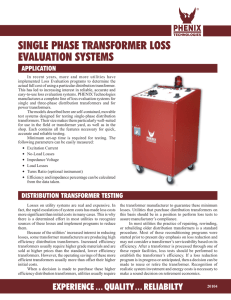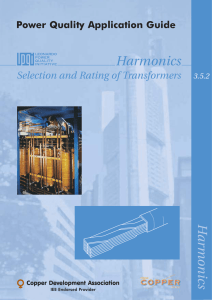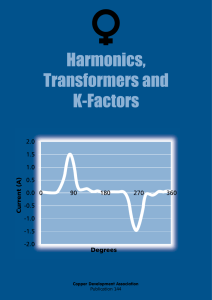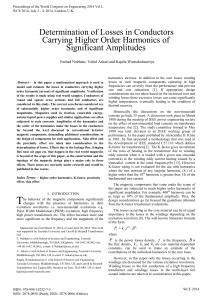transformers for wind turbine generators
advertisement
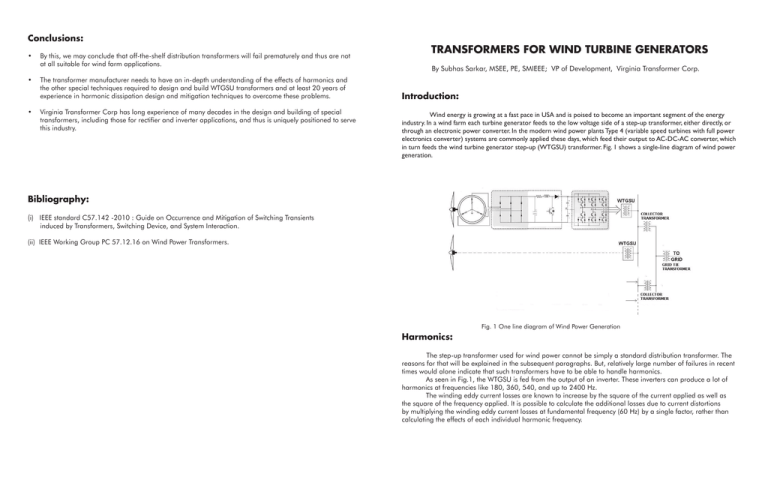
Conclusions: • By this, we may conclude that off-the-shelf distribution transformers will fail prematurely and thus are not at all suitable for wind farm applications. • The transformer manufacturer needs to have an in-depth understanding of the effects of harmonics and the other special techniques required to design and build WTGSU transformers and at least 20 years of experience in harmonic dissipation design and mitigation techniques to overcome these problems. • Virginia Transformer Corp has long experience of many decades in the design and building of special transformers, including those for rectifier and inverter applications, and thus is uniquely positioned to serve this industry. TRANSFORMERS FOR WIND TURBINE GENERATORS By Subhas Sarkar, MSEE, PE, SMIEEE; VP of Development, Virginia Transformer Corp. Introduction: Wind energy is growing at a fast pace in USA and is poised to become an important segment of the energy industry. In a wind farm each turbine generator feeds to the low voltage side of a step-up transformer, either directly, or through an electronic power converter. In the modern wind power plants Type 4 (variable speed turbines with full power electronics converter) systems are commonly applied these days, which feed their output to AC-DC-AC converter, which in turn feeds the wind turbine generator step-up (WTGSU) transformer. Fig. 1 shows a single-line diagram of wind power generation. Bibliography: (i) IEEE standard C57.142 -2010 : Guide on Occurrence and Mitigation of Switching Transients induced by Transformers, Switching Device, and System Interaction. (ii) IEEE Working Group PC 57.12.16 on Wind Power Transformers. Fig. 1 One line diagram of Wind Power Generation Harmonics: The step-up transformer used for wind power cannot be simply a standard distribution transformer. The reasons for that will be explained in the subsequent paragraphs. But, relatively large number of failures in recent times would alone indicate that such transformers have to be able to handle harmonics. As seen in Fig.1, the WTGSU is fed from the output of an inverter. These inverters can produce a lot of harmonics at frequencies like 180, 360, 540, and up to 2400 Hz. The winding eddy current losses are known to increase by the square of the current applied as well as the square of the frequency applied. It is possible to calculate the additional losses due to current distortions by multiplying the winding eddy current losses at fundamental frequency (60 Hz) by a single factor, rather than calculating the effects of each individual harmonic frequency. FHL - WE is the multiplier for winding eddy current losses. In terms of per-unit current, the winding eddy current harmonic loss factor is defined as Filter: An electrostatic capacitor provided between the primary and secondary windings creates capacitances between itself and the windings and acts as a filter to prevent the unwanted harmonics to pass through from the low voltage to the high voltage side (the collector bus). Thus, the WTGSU transformers have to be specially designed to mitigate the harmful effects of the harmonics and spikes and the resulting gassing. Loading Cycle: Where h is the harmonic number. The eddy current losses will therefore be equal to PtEC = PEC * (FHl-WE) Apart from the eddy losses, the harmonic currents also affect the stray losses. The “other stray loss harmonic enhancement factor” is defined as The other stray losses with harmonics will therefore be equal to P 'OSL = POSL ( F HL −OSL ) . These harmonics will cause increased eddy and stray losses within the windings as well as other metallic structures producing temperatures and stresses that can be 2 to 3 times higher than normal 60 Hz power wave form. Gassing: These extra losses will cause additional temperature rises in localized areas, and unless the coil and core are specially designed, to first of all reduce the additional losses and to handle the localized heating, it will lead to insulation loss of life, dissolved gases (DGA) generation and partial discharges (PD), all leading to premature failure. Normal life could be reduced from the normal 25 years, to 5 to 10 years. Occurrences of excessive gassing have been known in a large number of WTGSU transformers, reaching IEEE (DGA) gassing levels of condition 3 and 4 within a short period of service. Spikes: Due to inverter operation, some spikes, with high dv/dt, are present in the input voltage (though reduced by the filter). The additional electrical stresses are caused by these spikes (which contain a highfrequency component). These spikes are repetitive in nature and would cause deterioration of the insulation system. Therefore the WTGSU must be suitably designed to mitigate these spikes. Due to actual wind conditions, the running and loading conditions of the WTGSU are very different from the distribution transformer loads. First, the relatively long periods of time when the transformers is lightly loaded, or even idle, the core losses continue to occur. Thus for the sake of long-term economy, the core losses need to be kept low. This can be done by a core construction designed for lower losses with choice of core flux density and core geometry. The second problem is the variation of the load, which is cyclic, going from no-load to full-load and again to no-load. Compared to distribution transformers which usually see load cycling once a day, the WTGSU can see this cycle multiple times a day, depending on the conditions of the wind. The current flowing through the transformer windings also vary according to the load variation and results in thermal cycling. Such repeated cyclic variation in loading also produces mechanical stresses in the windings, insulation, clamping structures, etc, causing looseness of windings. It also causes the cooling fluid to undergo cyclic temperature fluctuations. The amount of gases dissolved in oil is a function of its temperature. Thus hot oil can absorb more gasses and when it cools, it releases the gases, which can sometimes cause formation of bubbles. These bubbles can cause hot-spots and give rise to partial discharge (PD), eventually causing deterioration of the insulation. Elimination of gassing will eliminate this mode of failure. Proper Sizing: The WTGSU should be properly sized for handling the unique conditions of wind power. If not properly sized, it would result in overheating and dielectric (voltage) stresses exceeding the limits of the insulation system. Both of these would result in generation of gases, of which hydrogen (H2) is the most prominent one. Some manufacturers simply increase the KVA rating to compensate; however this is not the effective solution and only adds to the losses generated because of the bigger transformer. Grounding transformers: Grounding transformers should be used in the high voltage side of the wind farm. Such grounding transformers provide a zero sequence impedance in the event of a single-line to ground fault, thus stabilizing system voltage and thereby over voltage on the WTGSU is avoided. Grounding transformers can be either zigzag connected, or a suitable delta-wye connected. The zig-zag connection is more popular. Switching Operation: Another big concern is transient over-voltage caused by switching. Due to wide variations in wind speed and consequent wide fluctuation in the power generated by the turbine, the unit can be switched off. In a given day, this can happen multiple times. The switching operation, particularly by vacuum circuit breakers, causes transient over-voltage. This is due to the current chopping producing high di/dt in conjunction with the inductance of the transformer windings and the capacitance of the cables. Though the magnitudes of the switching over-voltages due to TRV are lower than the BIL of the transformer, such phenomena can trigger a large oscillatory voltage within the windings and can cause failures. This subject has been dealt adequately in the IEEE standard C57.142-2010.
